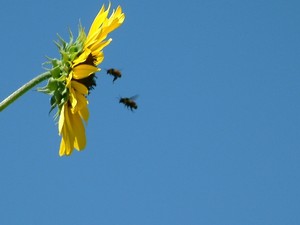09 Feb Mon 2009
Statistical Encouragement
We have farmed many places over the years and though our neighbors have always tried to urge us caution, though their words can be in effect discouragement.
“The gophers will eat your crops!” “The hawks, bobcats, lions, coyotes and dogs will eat your birds!” “Colony collapse disorder will kill your bees!” “The drought will dry out your soil!”
Among the advice we offer to new farmers and gardeners is caution.
A cautious farmer undertakes experiments and collects data to learn the truth of a matter. The cautious farmer understands from their data not only whether or not the gophers are eating the crops (perhaps it is the mice, or some other critter entirely?), but why (lack of alternative foods?)…and then is able to overcome the problem entirely!
Statistical analysis allows a complex understanding of the world that then prescribes solutions to even the greatest problems. This is because every phenomena you can observe has causes, and understanding the factors that influence the outcome of a scenario allows you to effect a more desireable outcome.
So, cautiously collect all kinds of data. For plants, there are several factors that are most important to the success or failure of the crop: the nutrition of the plants (water, soil composition and structure, and the presence of microorganism “friends” who help the plants eat), the predators of the plants (micro and macroorganisms), and the weather (espeically temperature and cloudcover). For animals (birds especially), you must also consider closely the nutrition of the animal, its predators (especially in regard to hygiene), and the weather (especially daylight).
Yet, minor factors should also be considered. We pay special attention to those minor factors that describe larger phenomena beyond our ken. Among these is the presence of organisms that pass through our farm as they migrate from place to place (as observed through footprints, excriment, and other impacts and pollution), and the global weather.
There are also non-numerical data to be considered. These must be translated into numerical values. If you observe, for example, that the plants look very “green” this year, create a coefficient of “how green?” by making a scale of green, from 90% white to 90% black tint. If you observe that the goats are acting very “goaty,” identify what “goaty” means in numerical terms to you.
You must also collect data on your impacts on the growing environment. These “controllable” factors might include the width of beds and aisles, the planted biodiversity, the maintained biodensity, and irrigation, supplimental feed, supplimental heat or light, etc.
When you have all the data, perform regression analysis and correlative analysis. You will quickly learn how the various factors you are observing impact each other, and how you’re helping or harming your production. Converting the terms into costs allows you to learn how to be more profitable!
We love statistics - they encourage us daily. A farmer who collects statistics on their operations understands that every problem has a solution, and has the confidence to undertake improvements to their practices. They are always learning, loving their world through observation. The stastistically impowered farmer works eyes wide open, ready to behold the wonder of the world - and kindly treat all creatures with whom they share it.

